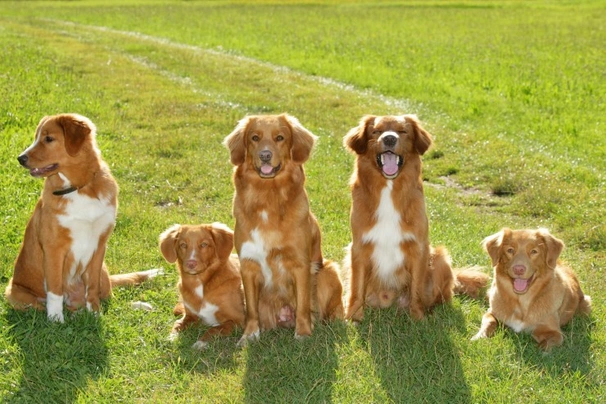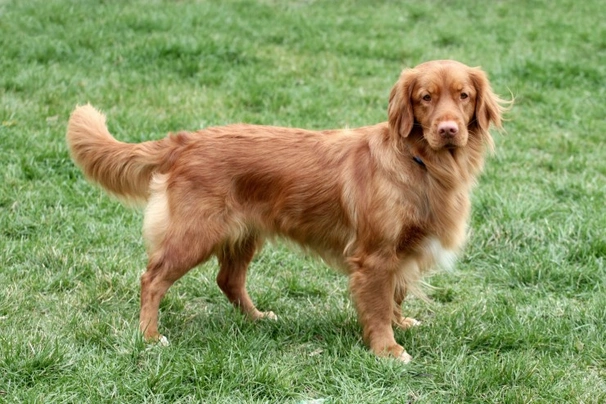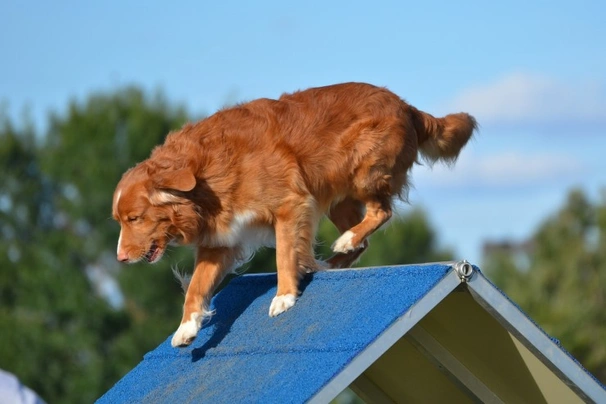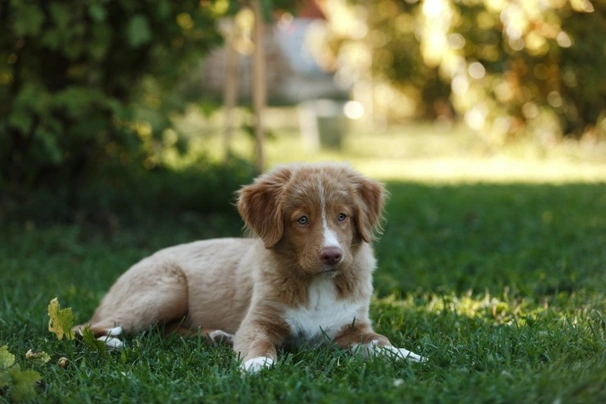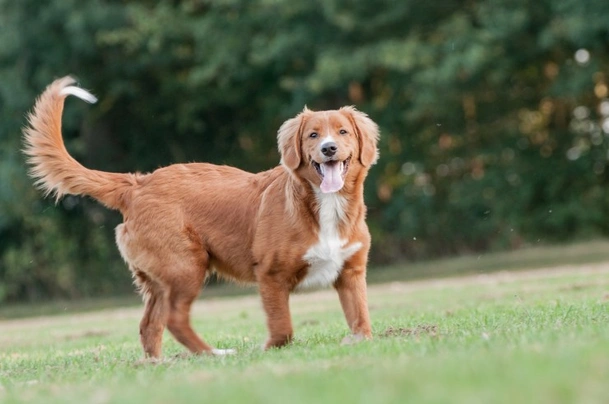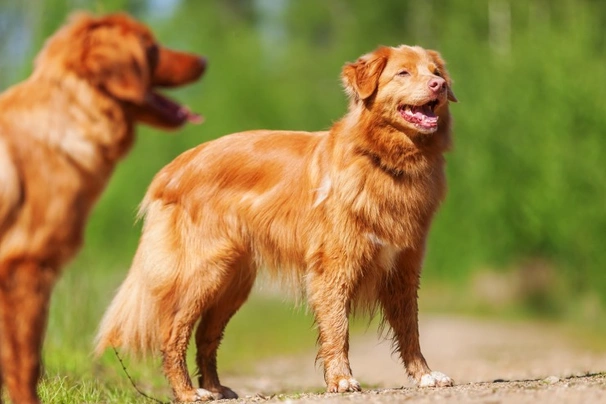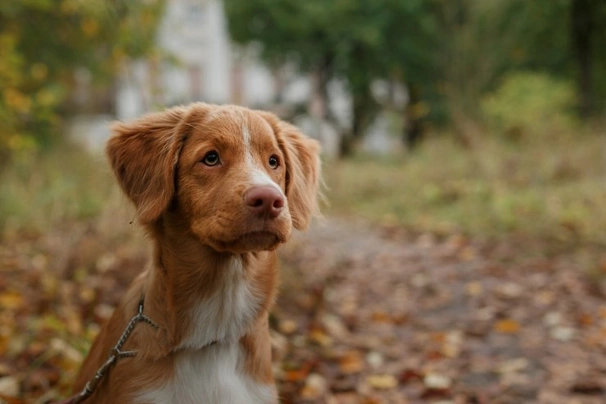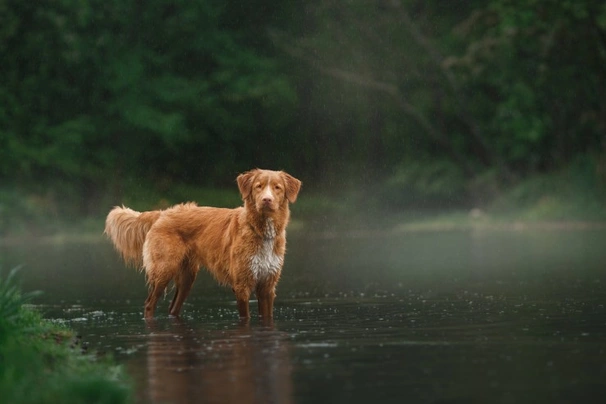Nova Scotia Duck Tolling Retriever
Pros
Cons
Introduction of the Nova Scotia Duck Tolling Retriever
Also known as a Toller the Nova Scotia Duck Tolling Retriever is a handsome dog being the smallest of all the retriever breeds. They look very much like the Golden Retriever and although they are popular as both companion dogs and family pets in the United States very few puppies are registered with The Kennel Club every year here in the UK as such anyone wanting to share a home with a Toller would need to register their interest with breeders first.
Tollers are a great choice for people who lead active outdoor lives because these intelligent dogs love nothing more than to be out and about having an abundant amount of energy they need to expend. They are not the best choice for first time dog owners although they do make wonderful family pets being especially good around children.
History of the Nova Scotia Duck Tolling Retriever
Although the exact origins of the Nova Scotia Duck Tolling Retriever are a bit of a mystery “decoy dogs” have existed in Europe for centuries and their job was to lure game birds like ducks into hunter’s nets. The dogs were smallish in size with ginger to red coats and there are those who believe that these dogs could well be the ancestors of the Tollers we see today.
With this said Nova Scotia Duck Tolling Retriever has an interesting history with records of their ancestors dating back to the 1890's when the dogs were first bred in Nova Scotia. They were bred as working gundogs during the early part of the twentieth century and proved to be excellent retrievers. It is thought the breed was created by crossing Golden Retrievers the Chesapeake Bay Flat-Coated Retrievers and Labradors although Cocker Spaniels working collies Irish Setters and even spitz-type dogs may also have been used to produce Tollers.
At first they were known as the Little River Duck Dog or Yarmouth Toller but in the late fifties when the breed was officially registered with the Canadian Kennel Club their name was changed to the Nova Scotia Duck Tolling Retriever. They were bred to “toll” which involves a dog running jumping and playing along a shoreline so that that game birds could see them which as a result brought the birds closer to the hunters. Tollers would then swim out and retrieve the birds.
These charming dogs first appeared here in the UK in the 1980's and since then the breed is slowing becoming a popular choice both as a companion dog and family pet. However the number of Tollers registered with The Kennel Club every year remains quite low which means puppies tend to be hard to find.
Interesting facts about the breed
- Is the Nova Scotia Duck Tolling Retriever a vulnerable breed? No although quite rare in the UK and well-bred Kennel Club registered puppies can often command a lot of money
- The breed was first introduced to the UK in 1988 by Miss Flack and Mr. French with dogs having been bought over from Canada
- Tollers have a tremendous amount of stamina and they are extremely strong swimmers
Appearance of the Nova Scotia Duck Tolling Retriever
Height at the withers: Males 48 - 51 cm Females 45 - 48 cm
Average weight: Males 20 - 23 kg Females 17 - 20 kg
The Nova Scotia Duck Tolling Retriever does look a little similar to the Golden Retriever having nice clean-cut heads that are slightly wedge shaped. They have a moderate stop and their muzzles taper neatly to a dog's nose. Their nostrils are well-developed and noses can be either black or flesh coloured. Eyes are medium in size and almond-shaped being set well apart with dogs always having an alert friendly expression in them. They can be brown to amber in colour depending on a dog's coat colour.
Ears are triangular in shape and they drop down being medium in size and set high and well back on a dog's head. They are well feathered at the back of the fold but the hair is shorter at the tips which are rounded. The Toller has a strong jaw with a perfect scissor bite where their upper teeth neatly overlap their lower ones. These dogs have a soft mouth which is essential in the breed even though their lips are tight fitting.
Their necks are moderately long and well-muscled. Shoulders are muscular moderately long and well laid back with dogs boasting straight strong front legs. Chests are deep with dogs having well sprung ribs and briskets that reach down to their elbows. Back are short and dogs have a level topline with strong muscular loins and neatly tucked up bellies. Back legs are well-muscled and strong with dogs having medium sized round and tight feet with well arched toes and strong webbing between them. Pads are thick and match the colour of a dog's coat. Tails are set high and slope slightly toward the croup being broader at the root and well feathered. Dogs carry their tails level with their backs when relaxed but curved upwards when excited or alert.
When it comes to their coat the Toller has a double coat that's made up of a straight weather resistant topcoat and a softer much denser undercoat. Their coats can have a slight wave on a dog's back and feathering around the throat behind the ears and on the back of the thighs with front legs there’s a moderate amount of feathering. The accepted breed colours for Kennel Club registration are as follows:
- Buff
- Buff and white
- Red
- Red and white
It is worth noting that the accepted breed colours for Kennel Club registration may differ from the colours set out in the breed standard.
Gait/movement
When a Toller moves they do so with a jaunty springy gait giving the impression of having a tremendous amount of power and showing a nice reach in the front and lots of drive from behind. They single track when they are moving fast and dogs carry their heads almost at the same level as their backs.
Faults
The Kennel Club frowns on any exaggerations or departures from the breed standard and would judge the faults on how much they affect a dog's overall health and wellbeing as well as their ability to perform.
Males should have both testicles fully descended into their scrotums and it is worth noting that a dog can be a little lighter or heavier as well as slightly taller or shorter than set out in the Kennel Club breed standard which is only given as a guideline.
Temperament of the Nova Scotia Duck Tolling Retriever
Tollers are known to be intelligent dogs that like nothing more than spending as much time in the great outdoors as they possibly can. As such they thrive on living with people who lead active outdoor lives making them a great choice for families who live in a country environment. They are a very good choice for first time owners because they are so intelligent and willing to please which when combined makes these dogs very easy to train.
However they are better suited to people who lead active outdoor lives and who would like to have an energetic canine companion at their side that boasts a tremendous amount of stamina. Like many other retriever-type breeds they can be a little nervous if not well enough socialised from a young age. As such puppies should be introduced to as many new situations noises people animals and other dogs once they have been fully vaccinated as possible so they grow up to be well-rounded confident and obedient mature dogs.
Are they a good choice for first time owners?
Tollers are a good choice for first time dog owners because they are so amenable and people-oriented loving nothing more than to please and to entertain their families. They are particularly good with young children and older people too although playtime can get a bit boisterous at times.
What about prey drive?
Tollers are very social by nature and although they have working and hunting dogs in their lineage they do not have a very high prey drive. However this is not to say that a dog would not give chase to a smaller animal when the mood takes them and this includes squirrels and the cat from next door.
What about playfulness?
Tollers have a very playful and fun-loving side to their natures and love nothing more than to entertain and be entertained. They are known to be a little mischievous when the mood takes them and being so clever a Toller quickly learns what pleases an owner so they can get their own way but always in the most endearing of ways.
What about adaptability?
As previously mentioned Tollers are better suited to people who lead active outdoor lives because they love being out and about doing something. They have a tremendous amount of stamina which makes them ideal jogging companions. They also benefit from being able to roam around a secure back garden as much as they can so they can really let off steam.
What about separation anxiety?
Tollers form strong ties with their families and dogs are never very happy when they find themselves left on their own for longer periods of time. They are better suited to people who either work from home or in households where one person stays at home when everyone else is out so they are never alone for any length of time which could see a dog suffering from separation anxiety. This can lead to them being destructive around the home which is a dog's way of relieving any stress they are feeling and a way to keep themselves entertained.
What about excessive barking?
Some Tollers like the sound of their own voices a little too much which is something that needs to be gently nipped in the bud when a dog is still young being careful not to frighten them. They have what is often referred to as a Toller “scream” which they like to do when they are excited about something. Others will only bark when there are strangers about or when something they don't like is going on in their surroundings.
Do Nova Scotia Duck Tolling Retrievers like water?
As their name suggests Tollers love being in and around water no matter what the weather. They are renowned for being extremely strong swimmers but care must always be taken when letting them run off the lead anywhere near more dangerous watercourses just in case a dog decides to leap in and needs rescuing.
Are Nova Scotia Duck Tolling Retrievers good watchdogs?
Tollers are not natural watchdogs although this is not to say a dog would not be quick off the mark to let an owner know when there are strangers about although they would rarely do this aggressively preferring to keep their distance and bark or “scream” incessantly to get an owner’s attention.
Intelligence / Trainability of the Nova Scotia Duck Tolling Retriever
The Toller is known to be an intelligent dog and one that is usually always ready and eager to please their owners. As such in the right hands and with the right amount of socialisation and training Tollers are known to be easy to train and are in fact very quick learners. However this means they are just as quick to pick up a few bad habits as they are the good. As such training as previously mentioned must start early bearing in mind these dogs respond well to voice and positive reinforcement training. Tollers excel at all sorts of canine sports which includes activities like agility and flyball. They have also proved to be very good at obedience and tracking.
Like all puppies Toller puppies are incredibly cute and it is all too easy to spoil them when they first arrive in their new homes. However cute puppies quickly grow up to be larger adult dogs which means that as soon as a Toller pup is settled in they must be taught the rules and boundaries so they understand what is expected of them. It also helps establish a “pecking order” and who is alpha dog in a household. The first commands a puppy should be taught are as follows:
- Come
- Sit
- Stay
- Heel
- Quiet
- Leave it
- Down
- Bed
Children and other
Tollers are known to be very well behaved around children and they seem to have a real affinity with them. However any interaction between the kids and dogs needs to be supervised by an adult to ensure playtime does not get too boisterous which could result in a child getting scared or hurt albeit by accident.
They are generally good around other dogs more especially if a Toller has been well socialised from a young age. If they have grown up with a cat in the household they usually get on well with them. However a Toller would think nothing of chasing any other cats. Care must be taken when they are around smaller animals and pets just in case their instinct to chase kicks in which could end in a disaster.
Health of the Nova Scotia Duck Tolling Retriever
The average life expectancy of a Nova Scotia Duck Tolling Retriever is between 10 and 14 years when properly cared for and fed an appropriate good quality diet to suit their ages.
Like so many other breeds the Toller is known to suffer from a few hereditary health issues which are worth knowing about if you are planning share your home with one of these active and good-looking dogs. The conditions that seem to affect the breed the most include the following:
- Prcd-PRA (progressive rod-cone degeneration) – DNA test available from OptiGen
- CEA/CH (Choroidal Hypoplasia - CH) - DNA test available from OptiGen
- Degenerative Encephalopathy (DE) – DNA test available
- Hip Dysplasia (HD) – tests available under the BVA/KC Hip Dysplasia Scheme
- Elbow Dysplasia (ED) - tests available under the BVA/KC Elbow Dysplasia Scheme
- Degenerative Myelopathy (DM) – test available from Laboklin and OFA
- Juvenile Addison’s Disease (JADD)/hypoadrenocorticism – test available from U C Davis
- Cleft Palate (CP1) and Cleft Lip/Palate Syndactyly (CLPS) – test available from U C Davis
- Chondrodystrophy (CDDY) and Invertebral Disc Disease (IVDD) - test available from U C Davis
- Congenital deafness – BAER test from the Animal Health Trust (AHT)
- Distichiasis
- SRMA (Steroid Responsive Meningitis Arteritis) / MUA (Meningoencephomyelitis of Unknown Aetiology)
- IMPA (Immune Mediated Polyarthritis)
- GME (Granulomatous meningoencephalitis)
- Epilepsy
It is worth noting that the Kennel Club coefficient for the Nova Scotia Duck Tolling Retriever is 2.4%.
What about vaccinations?
Toller puppies would have been given their initial vaccinations before being sold but it is up to their new owners to make sure they have their follow-up shots in a timely manner with the vaccination schedule for puppies being as follows:
- 10 -12 weeks old bearing in mind that a puppy would not have full protection straight away but would be fully protected 2 weeks after they have had their second vaccination
There has been a lot of discussion about the need for dogs to have boosters. As such it's best to talk to a vet before making a final decision on whether a dog should continue to have annual vaccinations which are known as boosters.
What about spaying and neutering?
A lot of vets these days recommend waiting until dogs are slightly older before spaying and neutering them which means they are more mature before undergoing the procedures. As such they advise neutering males and spaying females when they are between the ages of 6 to 9 months old and sometimes even when a dog is 12 months old which is the case for XX
Other vets recommend spaying and neutering dogs when they are 6 months old but never any earlier unless for medical reasons. With this said many breeds are different and it is always advisable to discuss things with a vet and then follow their advice on when a dog should be spayed or neutered.
What about obesity problems?
As with other breeds Tollers can gain weight after they have been spayed or neutered and it's important to keep an eye on a dog's waistline just in case they do. If a dog starts to put on weight it's important to adjust their daily calorie intake and to up the amount of exercise they are given. Older dogs too are more prone to gaining weight and again it's essential they be fed and exercised accordingly because obesity can shorten a dog's life by several years. The reason being that it puts a lot of extra strain on a dog's internal organs including the heart which could prove fatal.
What about allergies?
Some Tollers are prone to suffering from allergies and it's important for a dog to see a vet sooner rather than later if one flares up. Allergies can be notoriously hard to clear up and finding the triggers can be challenging. With this said a vet would be able to make a dog with an allergy more comfortable while they try to find out the triggers which could include the following:
- Certain dog foods that contain high levels of cereal and other grain-type fillers
- Airborne pollens
- Dust mites
- Environment
- Flea and tick bites
- Chemicals found in everyday household cleaning products
Participating in health schemes
All responsible Nova Scotia Duck Tolling Retriever breeders would ensure that their stud dogs are tested for known hereditary and congenital health issues known to affect the breed by using the following schemes:
- BVA/KC Hip Dysplasia Scheme
- DNA test - prcd-PRA
- DNA test - CEA/CH
- BVA/KC/ISDS Eye Scheme
- DNA test – DM
What about breed specific breeding restrictions?
Apart from the standard breeding restrictions for all Kennel Club recognised breeds there are no other breed specific breeding restrictions in place for the Nova Scotia Duck Tolling Retriever.
What about Assured Breeder Requirements?
It is mandatory for all Kennel Club Assured Breeders to use the following schemes on their dogs and all other breeders are strongly advised to follow suit:
- BVA/KC hip dysplasia scheme
- DNA test for prcd-PRA
- DNA test for CEA/CH
- DNA test for DE
The Kennel Club also strongly recommends that all breeders use the following scheme on their dogs:
- Eye testing through the BVA/KC eye scheme
- DNA test for DM
- Bitches that are under 2 years old should not produce a litter
- Bitches are not to produce more than a single litter in a 12-month period
- Dogs under the age of 2 years old should not be used for breeding purposes
Caring for the Nova Scotia Duck Tolling Retriever
As with any other breed Tollers need to be groomed on a regular basis to make sure their coats and skin are kept in top condition. They also need to be given regular daily exercise to ensure they remain fit and healthy. On top of this dogs need to be fed good quality food that meets all their nutritional needs throughout their lives.
Caring for a Nova Scotia Duck Tolling Retriever puppy
Toller puppies are boisterous and full of life which means it's essential for homes and gardens to be puppy-proofed well in advance of their arrival. A responsible breeder would have well socialised their puppies which always leads to more outgoing confident and friendly dogs right from the word go. With this said any puppy is going to feel vulnerable when they leave their mother and littermates which must be taken into account. The longer a puppy can remain with their mother the better although it should never be for too long either.
It's best to pick a puppy up when people are going to be around for the first week or so which is the time needed for a puppy to settle in. Puppy-proofing the home and garden means putting away any tools and other implements that a boisterous puppy might injure themselves on. Electric wires and cables must be put out of their reach because puppies love chewing on things. Toxic plants should be removed from flowerbeds and the home too.
Puppies need to sleep a lot to grow and develop as they should which means setting up a quiet area that's not too out of the way means they can retreat to it when they want to nap and it's important not to disturb them when they are sleeping. It's also a good idea to keep "playtime" nice and calm inside the house and to have a more active "playtime" outside in the garden which means puppies quickly learn to be less boisterous when they are inside.
The documentation a breeder provides for a puppy must have all the details of their worming date and the product used as well as the information relating to their microchip. It is essential for puppies to be wormed again keeping to a schedule which is as follows:
- Puppies should be wormed at 6 months old
- They need to be wormed again when they are 8 months old
- Puppies should be wormed when they are 10 months old
- They need to be wormed when they are 12 months old
Things you'll need for your puppy
There are certain items that new owners need to already have in the home prior to bringing a new puppy home. It's often a good idea to restrict how much space a puppy plays in more especially when you can't keep an eye on what they get up to bearing in mind that puppies are often quite boisterous which means investing in puppy gates or a large enough playpen that allows a puppy the room to express themselves while keeping them safe too. The items needed are therefore as follows:
- Good quality puppy or baby gates to fit on doors
- A good well-made playpen that's large enough for a puppy to play in so they can really express themselves as puppies like to do
- Lots of well-made toys which must include good quality chews suitable for puppies to gnaw on bearing in mind that a puppy will start teething anything from when they are 3 to 8 months old
- Good quality feed and water bowls which ideally should be ceramic rather than plastic or metal
- A grooming glove
- A slicker brush or soft bristle brush
- Dog specific toothpaste and a toothbrush
- Scissors with rounded ends
- Nail clippers
- Puppy shampoo and conditioner which must be specifically formulated for use on dogs
- A well-made dog collar or harness
- A couple of strong dog leads
- A well-made dog bed that's not too small or too big
- A well-made dog crate for use in the car and in the home that's large enough for a puppy to move around in
- Baby blankets to put in your puppy's crate and in their beds for when they want to nap or go to sleep at night
Keeping the noise down
All puppies are sensitive to noise including Toller puppies. It's important to keep the noise levels down when a new puppy arrives in the home. TVs and music should not be played too loud which could end up stressing a small puppy out making them withdrawn timid and shy.
Keeping vet appointments
As previously mentioned Toller puppies would have been given their first vaccinations by the breeders but they must have their follow up shots which is up to their new owners to organise. The vaccination schedule for puppies is as follows:
- 10 -12 weeks old bearing in mind that a puppy would not have full protection straight away but would only be fully protected 2 weeks after they have had their second vaccination
When it comes to boosters it's best to discuss these with a vet because there is a lot of debate about whether a dog really needs them after a certain time. However if a dog ever needed to go into kennels their vaccinations would need to be fully up to date.
What about older Nova Scotia Duck Tolling Retrievers when they reach their senior years?
Older Tollers need lots of special care because as they reach their golden years they are more at risk of developing certain health concerns. Physically a dog's muzzle may start to go grey but there will be other noticeable changes too which includes the following:
- Coats become coarser
- A loss of muscle tone
- Tollers can either become overweight or underweight
- They have reduced strength and stamina
- Older dogs have difficulty regulating their body temperature
- They often develop arthritis
- Immune systems do not work as efficiently as they once did which means dogs are more susceptible to infections
Older dogs change mentally too which means their response time tends to be slower as such they develop the following:
- They respond less to external stimuli due to impaired vision or hearing
- They tend to be a little pickier about their food
- They have a lower pain threshold
- Become intolerant of any change
- Often an older dog can feel disorientated
Living with a Toller in their golden years means taking on a few more responsibilities but these are easily managed and should include looking at their diet the amount of exercise they are given how often their dog beds need changing and keeping an eye on the condition of their teeth.
Older Tollers need to be fed a good quality diet that meets their needs at this stage of their lives all the while keeping a close eye on a dog's weight. A rough feeding guide for older dogs is as follows bearing in mind they should be fed highly digestible food that does not contain any additives:
- Protein content should be anything from 14 – 21%
- Fat content should be less than 10%
- Fibre content should be less than 4%
- Calcium content should be 0.5 – 0.8%
- Phosphorous content should be 0.4 – 0.7%
- Sodium content should be 0.2 – 0.4%
Older Tollers don't need to be given the same amount of daily exercise as a younger dog but they still need the right amount of physical activity to maintain muscle tone and to prevent a dog from putting on too much weight. All dogs need access to fresh clean water and this is especially true of older dogs when they reach their golden years because they are more at risk of developing kidney disorders.
Grooming of the Nova Scotia Duck Tolling Retriever
Tollers boast having moderately long but very waterproof coats that consist of a dense soft undercoat and coarser outer one which are not that high maintenance to keep looking tidy. A weekly brush is all it takes to keep their coats in good condition. However they shed quite heavily throughout the year although like other breeds they shed more during the Spring and then again during the Autumn when more frequent brushing is necessary to keep on top of things.
The hair on their feet and around their ears is longer and as such needs more frequent brushing to prevent knots and tangles from forming. It's also important to check a dog's ears on a regular basis and to clean them when necessary. If too much wax builds up in a dog's ears it can lead to a painful infection which can be hard to clear up. In short prevention is often easier than cure when it comes to ear infections.
Exercise of the Nova Scotia Duck Tolling Retriever
Tollers are quite high energy intelligent dogs and as such they need to be given the right amount of daily exercise and mental stimulation for them to be truly happy well-rounded and obedient dogs. This means walking a dog for at least 2 hours a day. They also love swimming which means care needs to be taken when walking a Toller anywhere near dangerous rivers ponds or other watercourses just in case a dog decides to jump in. With this said they really benefit from being allowed as much "off the lead" time as possible but always in a safe and secure environment.
A shorter walk in the morning would be fine but a longer more interesting one in the afternoon is a must. These dogs also like to be able to roam around a back garden as often as possible so they can really let off steam. However the fencing must be extremely secure to keep these active dogs in because if they find a weakness in the fence they will soon escape out and get into all sorts of trouble.
With this said Toller puppies should not be given too much exercise because their joints and bones are still growing and too much pressure on them could result in causing a dog a few problems later in their lives. They should not be allowed to jump up or off furniture nor should they be allowed to run up and down the stairs because this puts too much pressure on their still growing joints and limbs.
Feeding of the Nova Scotia Duck Tolling Retriever
If you get a Toller puppy from a breeder they would give you a feeding schedule and it's important to stick to the same routine feeding the same puppy food to avoid any tummy upsets. You can change a puppy's diet but this needs to be done very gradually always making sure they don't develop any digestive upsets and if they do it's best to put them back on their original diet and to discuss things with the vet before attempting to change it again.
Older dogs are not known to be fussy or finicky eaters but this does not mean you can feed them a lower quality diet. It's best to feed a mature dog twice a day once in the morning and then again in the evening making sure it's good quality food that meets all their nutritional requirements. It's also important that dogs be given the right amount of exercise so they burn off any excess calories or they might gain too much weight which can lead to all sorts of health issues. Obesity can shorten a dog's life by several years so it's important to keep an eye on their waistline from the word go.
Feeding guide for a Nova Scotia Duck Tolling Retriever puppy
Puppies need to be fed a highly nutritious good quality diet for them to develop and grow as they should. As a rough guide a Toller puppy can be fed the following amounts every day making sure their meals are evenly spread out throughout the day and it's best to feed them 3 or 4 times a day:
- 2 months old - 150 g to 208 g depending on a puppy's build
- 3 months old - 176 g to 246 g depending on a puppy's build
- 4 months old - 187 g to 264 g depending on a puppy's build
- 6 months old - 189 g to 270 g depending on a puppy's build
- 7 months old - 171 g to 250 g depending on a puppy's build
- 8 months old - 153 g to 233 g depending on a puppy's build
- 10 months old - 136 g to 194 g depending on a puppy's build
- 11 months old - 134 g to 192 g depending on a puppy's build
When a puppy is 12 months old they can be fed adult food.
Feeding guide for an adult Nova Scotia Duck Tolling Retriever
Once fully mature an adult Toller must be fed a good quality diet to ensure their continued good health. As a rough guide an adult Toller can be fed the following amounts every day:
- Dogs weighing 17 kg can be fed 215g to 283g depending on activity
- Dogs weighing 20 kg can be fed 234g to 308g depending on activity
- Dogs weighing 23 kg can be fed 253g to 334g depending on activity
Nova Scotia Duck Tolling Retriever price
If you are looking to buy a NSDR you would need to pay anything from £450 to over £700 for a well-bred pedigree puppy.
The cost of insuring a male 3-year-old Toller in northern England would be £21.20 a month for basic cover but for a lifetime policy this would set you back £47.37 a month (quote as of May 2016). When insurance companies calculate a pet's premium they factor in several things which includes where you live in the UK and a dog's age and whether or not they have been neutered or spayed.
When it comes to food costs you need to buy the best quality food whether wet or dry to feed your dog throughout their lives making sure it suits the different stages of their lives. This would set you back between £40 - £50 a month. On top of all of this you would need to factor in veterinary costs if you want to share your home with a Toller and this includes their initial vaccinations their annual boosters the cost of neutering or spaying your dog when the time is right and their yearly health checks all of which quickly adds up to over a £1000 a year.
As a rough guide the average cost to keep and care for a Nova Scotia Duck Tolling Retriever would be between £70 to £100 a month depending on the level of insurance cover you opt to buy for your dog but this does not include the initial cost of buying a pedigree puppy.
Buying advice
If you are looking to buy a NSDR you would need to pay anything from £350 to over £600 for a well-bred pedigree puppy. The cost of insuring a male 3-year-old Toller in northern England would be £23.67 a month for basic cover but for a lifetime policy this would set you back £49.76 a month (quote as of March 2018). When insurance companies calculate a pet's premium they factor in several things which includes where you live in the UK and a dog's age and whether they have been neutered or spayed amongst other things.
When it comes to food costs you need to buy the best quality food whether wet or dry to feed your dog throughout their lives making sure it suits the different stages of their lives. This would set you back between £40 - £50 a month. On top of all of this you would need to factor in veterinary costs if you want to share your home with a Toller and this includes their initial vaccinations their annual boosters the cost of neutering or spaying your dog when the time is right and their yearly health checks all of which quickly adds up to over a £1000 a year.
As a rough guide the average cost to keep and care for a Nova Scotia Duck Tolling Retriever would be between £70 to £100 a month depending on the level of insurance cover you opt to buy for your dog but this does not include the initial cost of buying a well-bred healthy Kennel Club registered pedigree Nova Scotia Duck Tolling Retriever puppy.


